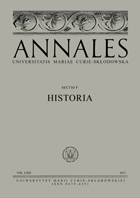Użyteczny wróg. Konflikty wojenne w filmie dokumentalnym na wybranych przykładach
The Useful Enemy: War Conflicts in Documentary Film through Selected Examples
Author(s): Jadwiga HučkováSubject(s): Film / Cinema / Cinematography, Sociology of Art, History of Art
Published by: Wydawnictwo Naukowe Uniwersytetu Marii Curie-Sklodowskiej
Keywords: documentary film; archives; war; nation; fascism;
Summary/Abstract: Documentary films about conflicts are perceived not so much as historical films as propaganda films. This is often the case even against the intentions of their authors. It is difficult to break away from already deeply ingrained patterns of thought: the way in which the narrative is conducted and ready-made patterns of representation are incorporated into accounts of reality. We refer to the category of struggle, we use opposites to define our own position. An outstanding example of this strategy is the Why We Fight series by Frank Capra and Anatole Litvak pitting free nations (Allies) against slave nations (Germany, Japan). In the post-war document, the negative reference point was primarily fascism. Since the 1990s (the war in former Yugoslavia), films describing conflicts have again pitted nations against each other. Over the last century, documentary cinema narrating wars has improved its technique. The narrative and the ways of arguing one’s case have not become particularly enriched. At the same time, film archives are becoming more widely available. Filmmakers find in them arguments for their constructions of thought. The danger of misusing archive material and constructing a black-and-white picture of reality was noticed just after World War II. In recent film productions, however, we find examples of both the conscious and responsible use of archives and the avoidance of easy juxtapositions.
Journal: Annales Universitatis Mariae Curie-Skłodowska, sectio F – Historia
- Issue Year: 78/2023
- Issue No: 1
- Page Range: 189-211
- Page Count: 23
- Language: Polish

